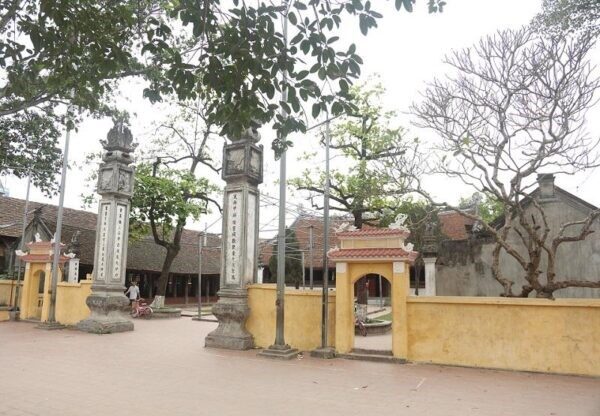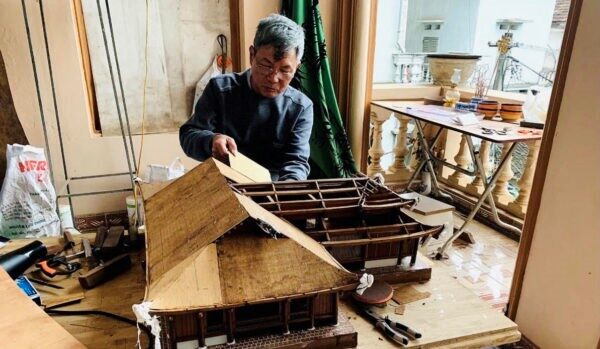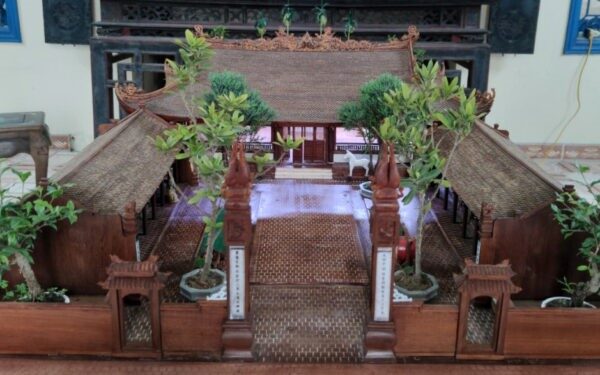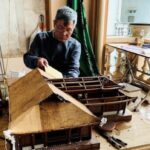
Huu Bang communal house in reality. Photo by Le Nhan
Huu Bang Communal House, formerly known as “Ke Nua” in Nom language, was recognized as a historical and cultural relic in 1989. The communal house was built in the Le Trung Hung period, in the reign of Chinh Hoa, worshiping the trinity of Nam Hai Kings as the village Citadel. In the communal house, there are still 27 ordinations from feudal dynasties. The trinity of tutelary gods were conferred the highest rank of god. The communal house has existed for more than 300 years and has become a place of cultural and social activities of 9 villages in the commune. For Huu Bang people like Mr. Hung, the communal house is the soul of the homeland engraved in their heart. At the age of seventies, he has a lot of free time and lives near the communal house. Therefore, Mr. Hung came up with the idea of making a miniature of the communal house.
According to Mr. Hung, in order to make the village communal house similar to reality, he has diligently researched and studied the architecture of the real one. Every morning, after doing exercise in the communal house yard, he spends time to look at the overview of the communal house, take pictures of the small details, then ponder on the method. Making a miniature of the house is extremely difficult. This work has too many details, so he has to do each step carefully and slowly because just a little deviation will immediately ruin the whole work. The first thing he did was making a drawing of the communal house area. He took the main communal house as the benchmark, dividing it according to the real ratio. He prioritized making the main parts first and then starting to work on the details. The artisan chose the Mahogany as raw material for the communal house model. He spent 6 to 8 hours a day performing complex processing that modern machines cannot do. He was very meticulous in working on the smallest details such as a pressed wood tile that was cut exactly like the roof tile in the communal house; The small tenon on the column, the brick floor and 壽-shaped door frame were elaborately crafted. In addition to wood material, some other small details such as the drum face were made of leather, some were vermilion lacquered and gilded to resemble reality; the aluminum symbol “two dragons adoring the moon” was cleverly restored. The real roof of the communal house is covered with about 100,000 small tiles, but the miniature version has only about 75,000 tiles. Mr. Hung could only install 1,500 tiles per day, so it took him nearly 2 months to complete. The position and shape of each tile and brick were arranged to resemble reality. In order to make the communal house vibrant, artisan Hung spent a lot of time searching for two Cedrus trees, two Terminalia catappa trees, two rheum trees and two champaca trees suitable for the small size of the communal house, making the model soulful. The detail that Mr. Hung is most interested in is that the door can be opened and closed like the real one.

Artisan Hung diligently crafting the miniature of Huu Bang communal house

The completed model of tiny Huu Bang communal house. Photo: Internet
Artisan Hung shared that when implementing this miniature, he encountered many difficulties because the model of the communal house is extremely small, so with large details, he had to use 2.5-degree far-sighted glasses; When working on the details, he had to glue together items as tiny as toothpicks using 4-degree glasses to see better. The cold weather in the North was also a hindrance making his hands numb so the processing became even more difficult. In contrast, when it was hot, despite the sweat pouring off him, he could not turn on the fan for fear of flying small details and destroy the whole work. Every time he finished a small detail or the whole house, he felt so happy. If his heath allows, he will build more models of communal houses and pagodas in the country.
After 5 years of researching, finding raw materials and processing, with passion and skillful hands, artisan Phan Lac Hung has faithfully and vividly created the miniature of Huu Bang communal house with scale 1/1000 and weight of about 60kg. The finished work reaches a level of sophistication and is almost exactly the same as the real one. Although it is a personal idea, the work of artisan Hung has practical significance in preserving architectural works of long-standing historical and cultural value in the locality.
Mai Phuong

